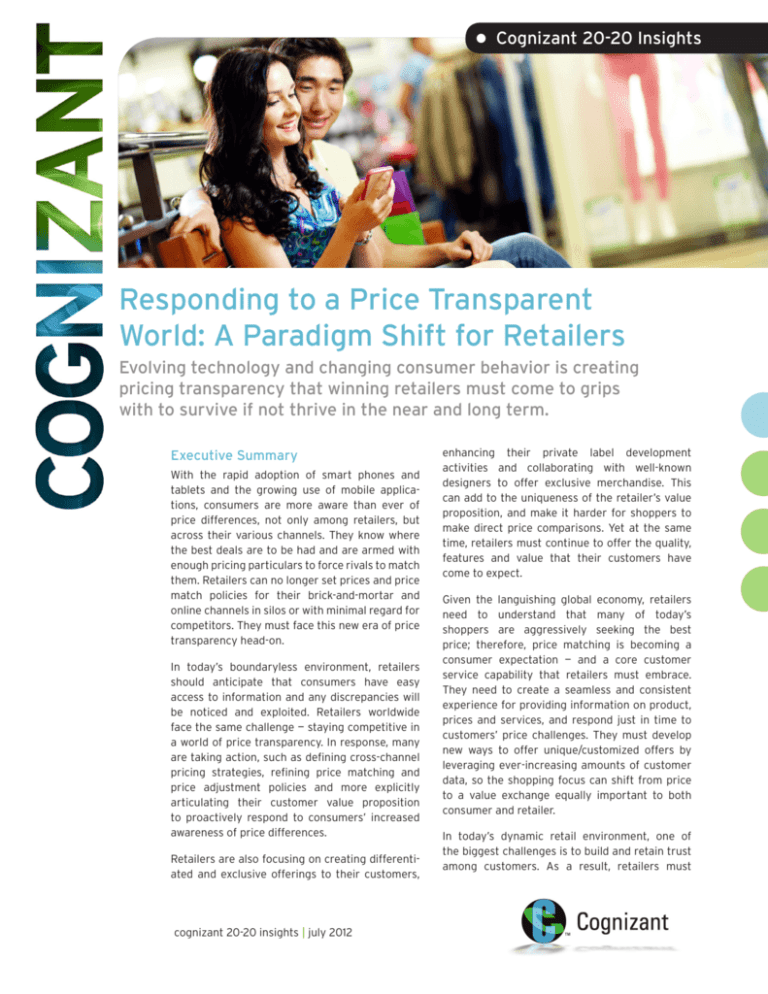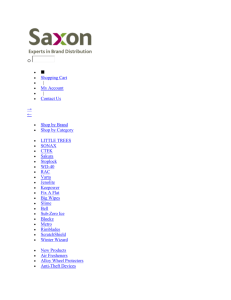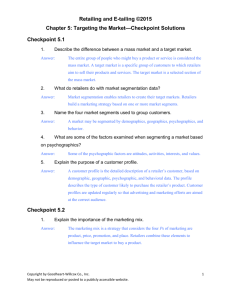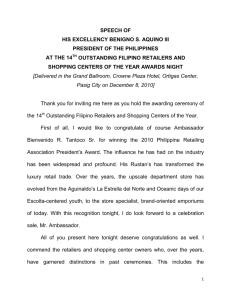
• Cognizant 20-20 Insights
Responding to a Price Transparent
World: A Paradigm Shift for Retailers
Evolving technology and changing consumer behavior is creating
pricing transparency that winning retailers must come to grips
with to survive if not thrive in the near and long term.
Executive Summary
With the rapid adoption of smart phones and
tablets and the growing use of mobile applications, consumers are more aware than ever of
price differences, not only among retailers, but
across their various channels. They know where
the best deals are to be had and are armed with
enough pricing particulars to force rivals to match
them. Retailers can no longer set prices and price
match policies for their brick-and-mortar and
online channels in silos or with minimal regard for
competitors. They must face this new era of price
transparency head-on.
In today’s boundaryless environment, retailers
should anticipate that consumers have easy
access to information and any discrepancies will
be noticed and exploited. Retailers worldwide
face the same challenge — staying competitive in
a world of price transparency. In response, many
are taking action, such as defining cross-channel
pricing strategies, refining price matching and
price adjustment policies and more explicitly
articulating their customer value proposition
to proactively respond to consumers’ increased
awareness of price differences.
Retailers are also focusing on creating differentiated and exclusive offerings to their customers,
cognizant 20-20 insights | july 2012
enhancing their private label development
activities and collaborating with well-known
designers to offer exclusive merchandise. This
can add to the uniqueness of the retailer’s value
proposition, and make it harder for shoppers to
make direct price comparisons. Yet at the same
time, retailers must continue to offer the quality,
features and value that their customers have
come to expect.
Given the languishing global economy, retailers
need to understand that many of today’s
shoppers are aggressively seeking the best
price; therefore, price matching is becoming a
consumer expectation — and a core customer
service capability that retailers must embrace.
They need to create a seamless and consistent
experience for providing information on product,
prices and services, and respond just in time to
customers’ price challenges. They must develop
new ways to offer unique/customized offers by
leveraging ever-increasing amounts of customer
data, so the shopping focus can shift from price
to a value exchange equally important to both
consumer and retailer.
In today’s dynamic retail environment, one of
the biggest challenges is to build and retain trust
among customers. As a result, retailers must
derive new ways to maintain the balance between
maximizing profits and creating and retaining
customer loyalty by rethinking traditional pricing
strategies and enhancing their promotion capabilities.
Price Transparency: Moment of Truth
A typical shopping scenario sheds light on
the growing challenges of price transparency.
Jennifer scanned a product for a price in a leading
retail store; it was $180 on the shelf. Checking the
price of the same product on the retailer’s Web
site using her smartphone, it was to her surprise
only $115. So, she ordered it via smartphone for
in-store pickup, saving $65 in the process!
While this is a fabricated story, situations like
this occur more often than you think. Thanks to
the rapid adoption of smartphones and tablets,
and the growth of mobile apps, shoppers today
have access to price information anytime and
anywhere in the world. With a million smartphones
sold every month in the U.S. alone,1 shoppers are
increasingly turning towards a growing number of
mobile apps and price comparison services to find
the best prices while they are shopping in-store
and online. A recent study conducted by the
marketing and public relations firm Walker Sands
Communications confirms the growing usage of
mobile technology: traffic stemming from mobile
devices to various Web sites across industries,
including retail, more than doubled, to 13% of
total Web traffic in Q4 2011 from 6% in Q4 2010.2
Customer Shopping Behavior
Shoppers are on a constant lookout for relevant
information such as prices, product specifications, and user reviews to assist them in
making informed decisions. According to the
RIS/Cognizant 2012 Shopper Experience Study,
competitive prices and promotions is the most
important influencer in both in-store and online
purchase decisions (see Figures 1 and 2).3
Understanding Buying Influences
How much do each of the following factors influence your in-store purchase decisions?
4.4
4.4
4.2
4.1
Competitive price and promotions
Right product selection
3.7
3.9
3.9
3.7
3.6
3.6
4.0
3.5
Fast, easy check-out
Quality of customer service
Visibility and accessibility of products
Ease of returning products
Compelling loyalty program
Other customers’ online ratings and reviews
2.7
2.6
2.3
Comments about the product on social media
0
1
2
■
■
Specialty Products
Consumable Products
3.2
3.3
3.3
3
4
Not an Influence
5
Extremely Influential
Source: RIS/Cognizant 2012 Shopper Experience Study
Figure 1
How much do each of the following factors influence your online purchase decisions?
4.3
Competitive price and promotions
Right product selection
Ease of returning products
Fast, easy check-out
Ease of accessing customer service
4.2
3.9
3.9
3.7
Other customers’ online ratings and reviews
Consistent experiences and information
online and on mobile devices
Compelling loyalty program
Personalized experiences
3.4
3.4
3.3
3.0
0
1
Not an Influence
2
Source: RIS/Cognizant 2012 Shopper Experience Study
Figure 2
cognizant 20-20 insights
2
3
4
5
Extremely Influential
In the current boundaryless shopping world,
consumers are becoming increasingly pricesensitive and less loyal, continuously trolling for
the best deals and more aggressive in seeking/
asking for a lower price. The
The shopping shopping journey is becoming
more
omni-channel
and
journey is becoming nonlinear in nature. Shoppers
more omni-channel may begin their journey at
and nonlinear a store, use a smartphone/
tablet to check online prices
in nature. and deals, read reviews and
social “likes” on the product,
go online again to make a purchase and then
go back to the store to pick up the product.
This growing trend is exposing the customer to
different prices by geography and channel within
a retailer’s chain and it colors their impressions
and experiences with the retailer.
The Norm, Not the Exception
Numerous studies highlight the fact that shoppers
are becoming increasingly active in comparing
prices. Among them:
• A study conducted by consultancy IDC Retail
Insights reveals that roughly 45% of shoppers
with smartphones used them to perform due
diligence on a store’s prices.4
• “The 2011 Social Shopping Study” published by
the e-tailing group notes that mobile phones
are one of the most popular influencers in
shoppers’ purchase decisions. Approximately
36% of respondents mentioned that when
researching a product while in a physical store
they look for competitive prices on Amazon. An
equal number replied that they look for competitive pricing at online retailers other than
Amazon.5
• A
study by AlixPartners found that 37% of
smartphone owners used a mobile price search
app while in a store, and 25% of those that
used an app then went on to purchase the item
from a nearby store at a lower price.6
The use of price comparison tools/apps is also on
the rise. A survey conducted by L.E.K found that
a substantial number of consumers used a price
comparison tool while standing in store aisles.7
Popular price comparison apps such as eBay
Inc.’s RedLaser and TheFind had 16 million and 1.4
million downloads, respectively, in 2011. TheFind
reports that its mobile app averaged 18 to 20
million price checks each month in 2011, up from
13 to 15 million checks per month in 2010.8
Retailers’ Challenges
According to research conducted by RSR in 2011,
retailers believe that “increased price transparency” is among the top business challenges driving
pricing strategies. Moreover, its importance
jumped markedly from 2010 to 2011 (see Figure 3).9
Retailers’ abilities to use price as a key differentiator and to price differently across channels is being
seriously compromised. The Internet and mobile
apps have conspired to break down the four walls
of the retail store. Shoppers know what and where
Transparency Drives Pricing Strategy
46%
Increased price senstivity of consumers
38%
Increased pricing aggresiveness from competitors
11%
Increased price transparency — the impact of
comparative pricing shopping
Need to protect our brand’s price image
Increased promotional intensity of competitors
40%
28%
N/A
■ 2010
14%
16%
10%
Respond to segment blurring
0
10
20
30
40
Source: Optimizing Price in a Transparent World, RSR Research Benchmark Report 2011
Figure 3
cognizant 20-20 insights
■ 2011
32%
7%
Need to provide more localized pricing
38%
32%
6%
Need to provide consistency in price across channels
58%
48%
3
50
60
the lowest price is and are willing to ask for it with
the expectation of receiving it. The ability for store
associates to match prices is the second most
desired area of store associate improvement, after
“better customer service skills,” and far ahead of
the third place choice (see Figure 4).
Also, according to research conducted by the
online review site Digital Trends in 2011, the search
for better pricing is a major reason for online cart
abandonment. The findings indicate that 27% of
shoppers abandon their cart to compare prices
on other sites and 25% abandon due to the price
being too high.10 Today’s connected consumers
know how to find the price they want to pay!
Responding to Increasing Price
Transparency
dependence of prices and policies in different
channels and locales. Rather than just setting
a chain price for all channels, or having each
channel set its prices independently, retailers
are taking a holistic view of pricing and policies
across the enterprise, and are understanding what their competitors do in different
channels, even though they may not directly
compete in all channels. Pricing, price-match
and return policies must be complementary
across all channels, recognizing that from the Technology has
customer’s standpoint it’s
proven to be both
all one company.
• Innovative
pricing
strategies: During the
2011
holiday
season,
several retailers offered innovative pricematching and price-adjustment tactics.
For example, Walmart launched a special
time-based price adjustment program in
advance of the 2011 holiday shopping season
and Amazon generated interest for its “Price
Check” application by offering shoppers a
5% discount (up to $5) on up to three items
purchased. Most of these solutions are only
temporary however, as price-matching and
price-adjustment tactics are in most cases
easily copied.
Technology has proven to be both a curse and
a blessing for retailers. For example, while
social media assists retailers in reaching out to
and connecting with their target customers in
real-time and innovative ways, conventional Web
and mobile apps are exposing price discrepancies
within their own channels. In today’s multichannel retail world there are few places where traditional localized/zonal pricing can be camouflaged,
reducing the effectiveness of these strategies.
To keep their customer base intact and retain the
pricing and services high ground, retailers are
responding in the following ways:
a
curse and a blessing
for retailers.
• Targeted marketing: With the advent of social
media, retailers have additional opportunities
to conduct targeted marketing initiatives on
their core customers. In a recent RSR study
surveying 65 retailers, 75% of the respondents
• Cross-channel
pricing strategies: Retailers
have begun to explicitly recognize the inter-
Consumer Pricing Expectations
Which of the following would you MOST like to see improved among store associates?
Improved customer service skills
35%
Ability of store associates to match
competitive prices (e.g. online)
29%
More store associate engagement in the aisles
14%
Better electronic access to product
information, inventory location and ordering
10%
Better product knowledge enabled by technology
7%
Equipped with mobile check-out tools
4%
0
5
Source: RIS/Cognizant 2012 Shopper Experience Study
Figure 4
cognizant 20-20 insights
4
10
15
20
25
30
35
40
agreed that targeted promotions offer an
opportunity to overcome the challenge of price
transparency.11
• Offering
exclusive products: Retailers are
investing heavily in offering exclusive products
to consumers, as these can be less vulnerable
to price comparison. Branded items that have
been slightly modified in features or packaging
make it more difficult for customers to conduct
an exact feature-to-feature assessment when
comparing prices. Many department stores and
specialty retailers have been private labeling
exclusive products for years. Price transparency increases the potential value of these types
of items and programs.
• Advanced price optimization solutions: With
the explosion of channels, competitors and
information, and the speed of change, retailers
need better tools to make timely decisions. The
value of advanced price optimization solutions,
for initial pricing as well as markdowns, is
increasing. These tools provide fact-based
analyses of customers and competitors, sifting
through vast amounts of data quickly, helping
retailers balance customer loyalty and satisfaction with maximized profits. It is becoming
increasingly important that
In a price-transparent retailers anticipate, not just
react to pricing trends and
world, retailers cannot market changes.
respond to the new strategy.
Sears Holdings has vastly increased its online
offerings in recent years and presents competitive prices, yet has under-invested in its brickand-mortar stores and has reported year-overyear declining sales.13 The company recently
announced plans to close 100-plus stores in a bid
to revitalize its business and reduce expenses. The
Sears experience suggests that to play in multiple
channels retailers can’t lag in any single channel.
Not having a compelling shopping experience
in one channel — whether it is product-, price-,
service- or ambiance-oriented — extends to all
channels.
In a nutshell, retailers must develop proactive
solutions that can help them to create and
maintain the balance between maximizing profits
and creating and retaining customer loyalty.
Our Point of View
We believe there are a few key concepts that
retailers must embrace if they wish to continue to
succeed in a price-transparent world.
• Increase your price intelligence: Price intel-
ligence can give retailers a strategic competitive advantage through insight-driven pricing
decisions and an optimized product mix across
channels, which ultimately helps increase conversions, sales and customer acquisition and
retention. A robust price intelligence solution
should integrate market, channel and competitive data with internal data in a near real-time
environment. It allows retail management to
gain a deeper understanding of what each
competitor price change means for margin and
market share, and how to formulate meaningful
responses.
afford to follow their
competition blindly or
let pricing strategies
be solely driven by
margin goals.
However, only retailers
with strong fundamentals will be able to survive
today’s cutthroat marketplace. Apart from competitive pricing, the growing
number of well-informed,
tech-savvy and bargain-hungry customers are
perpetually seeking the right product, right price,
knowledgeable sales associates, comfortable
store ambience and an overall pleasant shopping
experience.
• Rethink
traditional pricing strategies: In
a price-transparent world, retailers cannot
afford to follow their competition blindly or let
pricing strategies be solely driven by margin
goals. Rather, they must create pricing policies
which are in alignment with their brand image
and business goals and allow them to respond
to competition. Traditional pricing strategies
such as HiLo, EDLP, Loss Leader, etc. will continue to attract a certain segment of customers
and cannot be ignored – retraining customers
typically takes time. Retailers should meld their
existing strategies with new cross-channel strategies to ensure they do not negatively impact
existing customers’ expectations and perceptions.
JCPenney’s recent launch of its three-tier “Fair
and Square”12 pricing strategy is no doubt in
part a reaction to growing price transparency.
In a heavily promotional environment, having
the lowest — or at least a “competitive” — price
that can be viewed by the shopper or comparison
apps at any point in time is hit or miss. This is
especially true for occasional shoppers. The new
strategy may give the company a higher position
on price rankings, but it remains to be seen if its
traditional customer base can be retrained to
cognizant 20-20 insights
5
• Train
and equip store associates: When
customers go to a store, they still expect to find
informed and accessible store associates. At the
same time, they find it hard to understand why
associates do not have the same technology
and access to the same information they
have. As noted in our white paper “Building
the Intelligent Store,” retailers need to rethink
the concepts of selling and customer service.14
Retail associates need to be equipped with
technology that is on par with the customer’s.
Associates need to be trained to articulate
the store’s value proposition and the pricing
it drives, and policies/procedures need to be
streamlined to allow easy price matching while
at the same time having proper controls and
monitoring.
• Target
promotions by customer rather
than channel: Retailers must avoid creating
noticeable price conflicts. Loyalty-based
pricing allows a retailer to differentiate prices
between regular customers and occasional
shoppers in an open, yet personal “my price”
way. By using this technique, a retailer can
differentiate between loyal and non-loyal
customers and pass additional benefits to loyal
ones. It also allows the retailer to deliver on the
brand promise in the way that best resonates
and recognizes the price elasticity of each
customer.
• Increase private label or “customized” prod-
ucts/packaging: Price comparisons for private
label or customized items have been difficult
due to the lack of explicitly identical products.
However, comparisons to similar products may
become easier with the advent of image-based
search launched by Google and Amazon. With
this new technology, shoppers can submit a
hosted or uploaded photo and the search will
return images and text.
Conclusion
Price transparency is a hard reality for retailers
to master. Today more than ever, “the customer
is king.” New technologies and intermediaries
have given them more control over the shopping
journey; the ease of comparing prices plays a big
part in that.
But in the midst of this changing paradigm,
retailers should not lose site of the fact that there
is almost always something consumers value
alongside price. The challenge is to find the right
value exchange and imbed it in the company’s
business objectives so that it flows within the
organization and becomes a part of anything and
everything which the retailer does.
Footnotes
1
“The Marketplace of the Mobile Consumer: What to Expect,” L.E.K. Consulting, Vol. XIII, Issue 14.
http://www.lek.com/sites/default/files/L.E.K._Marketplace_of_the_Mobile_Consumer.pdf
2
“Quarterly Mobile Traffic Report,” Walker Sands Communication, Q4 2011.
http://www.walkersands.com/quarterlymobiletraffic#info
3
“2012 Shopper Experience Study,” RIS/Cognizant, May 2012. http://risnews.edgl.com/retail-research/3rdAnnual-Shopper-Experience-Study--Enabling-Retail-Without-Boundaries80337
4
”The New Era of Price Transparency,” Greg Girard, IDC Retail Insights, Dec. 2010.
http://online.wsj.com/article/SB10001424052748704694004576019691769574496.html
5
”The 2011 Social Shopping Study,” Lauren Freedman, President, the e-tailing group, June 2011.
http://www.powerreviews.com/assets/download/Social_Shopping_2011_Brief1.pdf
6
Financial Services Quarterly, Q1 2012, AlixPartners.
http://www.alixpartners.com/en/LinkClick.aspx?fileticket=YBdUg5n0eMg%3d&tabid=1426
7
”The Marketplace of the Mobile Consumer: What to Expect,” L.E.K. Consulting, Vol. XIII, Issue 14.
http://www.lek.com/sites/default/files/L.E.K._Marketplace_of_the_Mobile_Consumer.pdf
8
“Retailers Try to Thwart Price Apps,” Dana Mattioli, The Wall Street Journal, Dec. 23, 2011.
http://online.wsj.com/article/SB10001424052970203686204577114901480554444.html
9
”Optimizing Price in a Transparent World,” Benchmark report by Nikki Baird and Paula Rosenblum,
Managing Partners in Retail System Research, April 2011. http://www.sas.com/news/analysts/optimizingprice-in-a-transparent-world.pdf
cognizant 20-20 insights
6
10
”Abandonment Issues,” Digital Trends, March 2011. http://www.lixto.com/wp-content/uploads/2011/07/
Lixto-Reducing-Online-Abandonment-WP.pdf
11
”Optimizing Price in a Transparent World,” Benchmark report by Nikki Baird and Paula Rosenblum,
Managing Partners in Retail System Research, April 2011. http://www.sas.com/news/analysts/optimizingprice-in-a-transparent-world.pdf
12
“J.C. Penney Says ‘No Sale’: Cuts All Prices, All The Time to Simplify Bargain Hunting,”Daily Finance, The
Associated Press, Jan. 25, 2012. http://www.dailyfinance.com/2012/01/25/j-c-penney-says-no-sale-cutsall-prices-all-the-time-to-sim/
13
”Holiday Sales Woes Cast Cloud Over Sales,” Miguel Bustillo and Ann Zimmerman, The Wall Street
Journal, December 28, 2011. http://online.wsj.com/article/SB100014240529702034791045771241519245
31994.html
14
“Building the Intelligent Store,” Steven Skinner and Deepthi Timmasarthy, Cognizant white paper, October
2011. http://www.cognizant.com/InsightsWhitepapers/Building-the-Intelligent-Store.pdf
About the Authors
Greg Kameika is a Senior Manager with Cognizant Business Consulting’s Retail Practice. He has over
20 years of experience consulting to retail clients in the areas of pricing, merchandising and inventory
management. Greg received his BA from Northwestern University and his MBA from the Kellogg School
of Management at Northwestern. He can be reached at Gregory.Kameika@cognizant.com.
Pooja K Khudania is a Senior Consultant with Cognizant Business Consulting’s Retail Practice. She has
over eight years of experience consulting to retail industry clients. Pooja received her diploma in retail
marketing and merchandising management from National Institute of Fashion Technology, Bangalore,
India, and is a commerce graduate from Delhi University. She can be reached at Poojakumari.K@
cognizant.com.
About Cognizant
Cognizant (NASDAQ: CTSH) is a leading provider of information technology, consulting, and business process outsourcing services, dedicated to helping the world’s leading companies build stronger businesses. Headquartered in
Teaneck, New Jersey (U.S.), Cognizant combines a passion for client satisfaction, technology innovation, deep industry
and business process expertise, and a global, collaborative workforce that embodies the future of work. With over 50
delivery centers worldwide and approximately 145,200 employees as of June 30, 2012, Cognizant is a member of the
NASDAQ-100, the S&P 500, the Forbes Global 2000, and the Fortune 500 and is ranked among the top performing
and fastest growing companies in the world. Visit us online at www.cognizant.com or follow us on Twitter: Cognizant.
World Headquarters
European Headquarters
India Operations Headquarters
500 Frank W. Burr Blvd.
Teaneck, NJ 07666 USA
Phone: +1 201 801 0233
Fax: +1 201 801 0243
Toll Free: +1 888 937 3277
Email: inquiry@cognizant.com
1 Kingdom Street
Paddington Central
London W2 6BD
Phone: +44 (0) 20 7297 7600
Fax: +44 (0) 20 7121 0102
Email: infouk@cognizant.com
#5/535, Old Mahabalipuram Road
Okkiyam Pettai, Thoraipakkam
Chennai, 600 096 India
Phone: +91 (0) 44 4209 6000
Fax: +91 (0) 44 4209 6060
Email: inquiryindia@cognizant.com
­­© Copyright 2012, Cognizant. All rights reserved. No part of this document may be reproduced, stored in a retrieval system, transmitted in any form or by any
means, electronic, mechanical, photocopying, recording, or otherwise, without the express written permission from Cognizant. The information contained herein is
subject to change without notice. All other trademarks mentioned herein are the property of their respective owners.









